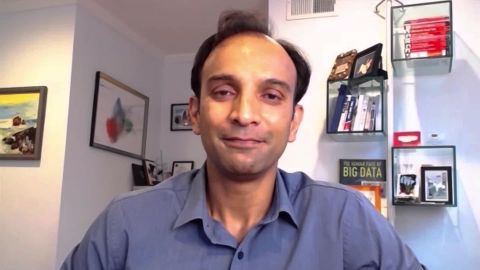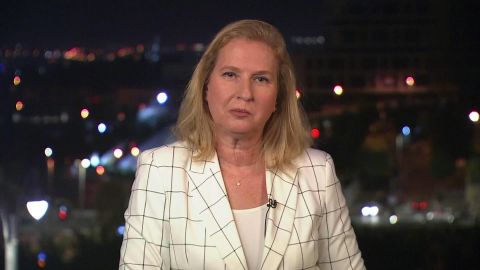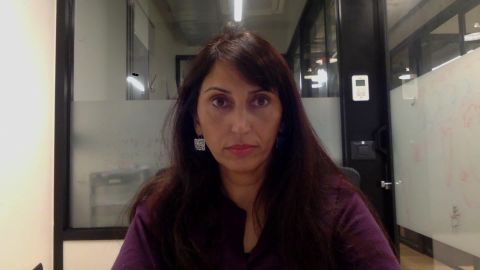Read Transcript EXPAND
CHRISTIANE AMANPOUR: Now, new coronavirus infections have soared to record highs in six American states, including the three most populous states, Texas, California and Florida. The governor of California, Gavin Newsom, is pleading with his residents to take precautions. Our next guest, D.J. Patil, has written a report on lessons learned to get ready for the next wave. He became America’s first chief data scientist under President Obama, and he is currently head of technology for a health care company, but he is taking unpaid leave to help California fight the pandemic. And here he is talking to our Hari Sreenivasan us about how crunching the numbers will be key to mitigating this virus.
HARI SREENIVASAN: Thanks, Christiane. D.J. Patil, welcome. You have been volunteering with the state of California and you have been consulting with other state governments over the past three months, trying to help them tackle the data around COVID. What have you learned so far?
D.J. PATIL, FORMER U.S. CHIEF DATA SCIENTIST: Well, the fascinating thing is that the number of people that have all come to work on COVID problems. This is just such a unique period of time. And the governments need new technologists. They need data, people — they need all the help that they can get. Really, what I have taken away from this effort is that we’re, one, at the very, beginning early on COVID. Two is that, as we think about how to manage COVID into this next phase, we really need drastic new approaches, and much of that is the need to be data-driven. We’re seeing this happen in companies. We’re seeing this happen in so many different sectors, but it’s how do we use data in novel ways to really power the next wave of the response.
SREENIVASAN: You took a leave of absence from your current job to work with the state of California. Why?
PATIL: Well, the company that I work for is called Devoted Health. And we’re responsible for more than 17,000 senior citizens. And when I watch what’s happening with COVID, as we watch for our population, it’s very clear that they’re in the bullseye. And we need to do everything that we possibly can. As we were working to safeguard and make sure that they’re getting everything they need, it was very clear that not enough was happening at the state level or the federal level. And so, as we thought about it, we thought what’s the most useful thing that I can do with my time would be to help the state and help — and by helping California, with 40 million people, we would develop systems and ideas that would then go to other states that would then help our population, because COVID doesn’t, frankly, care about geographic boundaries, as we know. So the idea is really to kind of help lift up the entire system to support our population, as well as everyone else’s.
SREENIVASAN: Now, we’re seeing numbers in California start to track back up. Did they do something wrong?
PATIL: I think what we’re finding is, once again, the part about that we’re early in COVID, trying to understand what’s happening. Two is, opening up the economy has consequences. Not everyone opens up safely. We have had groups where people go out to restaurants and bars, and they’re really close in proximity, and they’re not taking COVID seriously. And we’re starting to hear those stories where a friend, group of friends went, and a big percentage of them all came down with COVID. We’re also seeing the limits of what different counties and approaches can do. So, you can have one county that says, we’re not going to take COVID seriously. We may think of it as a hoax. We’re not going to at force masks. We see other places where they take it very seriously. One of the interesting things is, why is the San Francisco Bay area doing better than L.A. And in that first run-up for watching what COVID was having the impact on the U.S., one of the things that was seen for — particularly if you look at restaurant data receipts, is, seven to 10 days before the state-at-home orders were put in place, people already had stopped going to restaurants. People just said, look, this isn’t safe. They decided themselves, rather than having someone decide for them. Other parts of California, L.A. included, have not, or did not have that happen. Also, the industry, the tech community largely said, workers, stay at home. So, the Bay Area was already largely sheltering in place for a certain portion of the population, and that dramatically helped things out. So, what is — what do we need to do next to that is learn from one county to another. And, luckily, the mayors of the cities are actually starting to share that. But this also comes down — this aspect of, the more we attack the public health care officials, the less chance we have to actually getting these lessons learned and implemented.
SREENIVASAN: Are you hearing that frustration from the public health officials, the mayors, the county commissioners that you’re talking to and working with right now?
PATIL: Well, the place I hear it the most is from the public health officials, who are all questioning whether this is worth it. And those are the worst and saddest calls I have, because we need them. And they’re saying, look, I’m in this conversation with my county supervisors, and they’re not listening to me. I’m getting death threats, and no one’s standing up for me. And that is just — it just erodes them over time. It just — they just can’t take it anymore. We’re starting to see resignations start to take place. And, unfortunately, I expect a number of more resignations, not just across the states, but — like the state of California, but across the country, as a result.
SREENIVASAN: Why, on the modeling end of things, was it so difficult or is it so difficult to figure out where our resources are necessary? On the one hand, you had requests for ventilators that were unnecessary. On the other hand, you had PPP falling short where it should not have, right? And in this climate, each of these failings ends up getting weaponized because of the politics of the day.
PATIL: Much of the data that we have relied upon for models is really data that is critically shared between countries. A lot of that is brokered by the WHO, World Health Organization. That’s actually why it’s so important to remain part of these organizations, because that’s how we share and collaborate. The way to think about models is, this is the early days in many ways parallel to weather forecasting. Imagine we had weather models, but we didn’t really have weather balloons or planes or satellites, and we just had a few people going outside and sticking their finger in the wind and saying, yes, the wind is blowing to the south today? We don’t have a sensory network. We don’t have models that are very sophisticated and running on supercomputers like we’d like to think. These models are rather simplistic. Some of the models just try to fit curves and try to figure out how the line best looks to the data. Others try to model the dynamics, what are known as mechanistic models. But the thing that’s there — and this was called for when I was in the Bush administration, and it’s been continuously called on — is that we don’t have a national center for disease forecasting. We don’t have a collective effort. It’s actually two things. One, we don’t have a good way of capturing data, getting data that’s through large-scale testing, this electronic testing data, the documents being fully digital and moved around in an appropriate way and getting that foundation of data. The second is, we don’t share. We’re not sharing enough of our results. We’re not opening up our data to collaborate, moving things around. The — during the Obama administration, we had a very strong push to make sure all data, by default, is open and machine readable. The more states open up the data, the better the quality of modeling will be.
SREENIVASAN: So, what would you tell the president now about this?
PATIL: COVID is real, it’s early, it’s not going to go away anytime soon, and it’s going to need the full force of every aspect of what we have as the United States to tackle this. And every day that we move forward without tackling this is an increase in cost of life and economics. We have the ability to both lose the public health war and the economics war, if we’re not careful. And both are tragedies. It’s unbelievable that we’re talking about close to — well, well past 100,000 lives, getting to 120,000. We’re seeing estimates getting up there by October in the 180,000 to 200,000 range. And it’s important to remember that every one — these data points have names. They’re loved ones. And they’re disproportionately impacting blacks and people of indigenous origin. So, we have got to get ahead of that. And the part that that’s going to need is to some very classic things. One is, we all have to be on the same page together. We have to act as a unified force. And that means doing simple things like wearing a mask. I wear the mask not because I’m protecting myself, but because I want to protect you. I want to be a good, responsible citizen. Two, we need to really think about, what does it mean to protect the vulnerable? Third, how do we get the infrastructure in place, knowing that COVID is going to be here for a while? And, frankly, COVID isn’t the big one. We have to get ready for a pandemic that is far more virulent, because of pandemic influenza or new diseases that are going to be showing up. We have to get the infrastructure, and it takes time to get that infrastructure. So start laying the tracks down now. And then, finally, come to the defense of the public health officials. It’s not just public health officials like Fauci, but all the local public health officials, Amy Acton in Ohio or others, and start encouraging data scientists and technologists to jump in and take their skills to bring it to governments, to the local county levels, to help support the system in new novel ways.
SREENIVASAN: How would you rate the responses that we have had on — perhaps on a California scale that you have been looking at closely, but also on a federal level?
PATIL: Well, like, the state level has been one where I think what we have found is, everyone is kind of swarming to the problem. What I think we get very effectively as a nation in many of the states has been collectively to get — to flatten the curve, which was to really shelter in place and stay at home. Why is that so critical? We needed to buy time for our health care system to catch up, to get the beds in place, to get the protective gear in place, to start getting testing in place, to put all those things in. We have had to get testing ramped up across the drive-throughs. How do we enable that to be better? What we haven’t done is accelerated that even more. There’s still testing that’s going on, but how do we make sure that it’s used? We still have challenges in use. We still haven’t seen this idea of contact tracing, which is, once somebody is infected, how to find all the other people who might have been impacted. How do we get that collectively rolled out? And we need much more of that happening at the state level. At the federal level, that we just haven’t seen a cohesive movement. And we have seen this argument just to make it the states’ problems, and the states aren’t prepared, and so they make it the county problems. And then the counties are trying to just figure out how to do this with very threadbare budgets. So, we need a more collective strategy and a recognition that we have to have a strategy as a nation that is going to have to work on this, rather than the county to my north and me having a different strategy from the county to the south. Everyone has to be in it together.
SREENIVASAN: We have also got a culture of denialism here. I mean, we have got not only people who are actively saying that this is fading away, this is — that we have won this fight already. But that’s having consequences, when people are going to restaurants. And, as a nation, we’re collectively seeing that flattening of the curve kind of come back up.
PATIL: We’re already seeing the rise of the cases. The cases are already starting to go up. What we still don’t — and this shows, like, how early our understanding of COVID is, is, why does it go up so fast in certain places and not as much in others? One of the challenges — and we have seen this really in an unfortunate way — we have seen states like Arizona, where they said no to the team of modelers that have been supporting them, thanks, but no thanks. We don’t need you anymore, because we got this under control. The latest data shows they clearly have not. They clearly do not. And, luckily, thanks to public pressure, that they have brought those modelers back in to support them. But we have also seen data scientists in Florida who have been — work for the Florida government who’ve been under attack for reporting flaws of the data or inaccuracy. Or, in Georgia, even the way they presented the data makes it misleading. The data is about having a conversation. It’s an honest thing. And odes it feel good when those cases go up and you look at it? No, it’s not supposed to feel good. What it’s supposed to do is help us figure out, what are we going to do next? And just turning a blind eye to the data, and, as you said, you can’t fix what you can’t measure. We have to have this as a truly data- and-science-driven approach. And it’s about acceleration of our understanding.
SREENIVASAN: You recently wrote about kind of the intersection of the protests and COVID. Tell us about that.
PATIL: Well, this actually — as we think about the protests and COVID, one of things that I think we need to really be asking about is, what does it look like for us to really understand the roots of the protests? And that is fundamentally how we police. How do we actually structurally measure these pieces of the problem? There are so many times when a very basic question is asked by a police chief, a mayor, a governor, something simple, like, what’s the — what percentage of the population who is stopped are black vs. another population? And the number of times the answer is, we don’t know, because we can’t get that information. I hear that all the time on COVID. I don’t know. We can’t get that information. And it’s unbelievable that, in this day and age, we’re not willing to go to the effort or the lengths to go get that information to do this. I’m also very concerned about the use of data and creating a surveillance state and making sure that data is used responsibly. There’s an incredible amount of technology that’s being used for facial recognition. We know that there’s issues of bias in there. Police departments have access to this technology. And they’re using it in other ways, sometimes identifying people who are not peaceful protesters, but there’s a question of, where does that data go? Who has oversight to it? And what if somebody is wrongly accused of something or that’s not them? And how do they clear their name? And we have seen this happen time and time again, and we should take the lessons that we learned from how we have built these systems and where we have done it well and where we haven’t after 9/11, and really figure out, what does it look like to start putting these new systems together, and doing it in a responsible way?
SREENIVASAN: D.J. Patil, thanks so much for joining us.
PATIL: Thank you.
About This Episode EXPAND
Christiane speaks with Fmr. Israeli Foreign Minister Tzipi Livni and former legal adviser to the Palestinian Liberation Organization Dianna Buttu about Israel’s plans to annex parts of the West Bank. She also speaks with reporter Mary Jordan about her new unauthorized biography on Melania Trump. Hari Sreenivasan speaks with former U.S. Chief Data Scientist DJ Patil about mitigating this pandemic.
LEARN MORE



